A spectacular lawn or bright flowering plants today will surprise no one. But the stones are able to bring zest, make the landscape unique in its kind. And the stone will also help hide errors and highlight the strengths of the design.

Modern landscape design cannot be imagined without any "stone history"
Material features
Content
- Material features
- Where to buy
- Varieties of stone jewelry
- Video: Stones in a Natural Style Garden Landscape
- Photos of examples of the use of stones in landscape design
Typically, when planning a garden plot design, three main components are taken into account: plants, water, and stone. The latter can be natural or artificial.

Natural stones are suitable for both practical and decorative purposes, with one often complementing the other.
Natural material has several advantages:
- Unlimited service period.
- Resistance to weathering and temperature extremes.
- Natural aesthetics.
- Strength.
- Environmental friendliness of the material (with the exception of cases when the rock was mined using harmful chemical compounds).
- The ability to use multiple times. Especially when it comes to gabions or abstract sculptures.
Depending on the size of the stones, there are:
- Boulders. These are large stones of a rounded shape, the result of the influence of natural elements.

When choosing boulders for decorating a garden, it is better to give preference to dim rocks of natural tones.
- Cobblestones. They have a similar shape, but differ in origin. It is a rock formation. The most commonly found are jasper, granite or quartz. Usually such a stone is used for the construction of walls or paving roads.
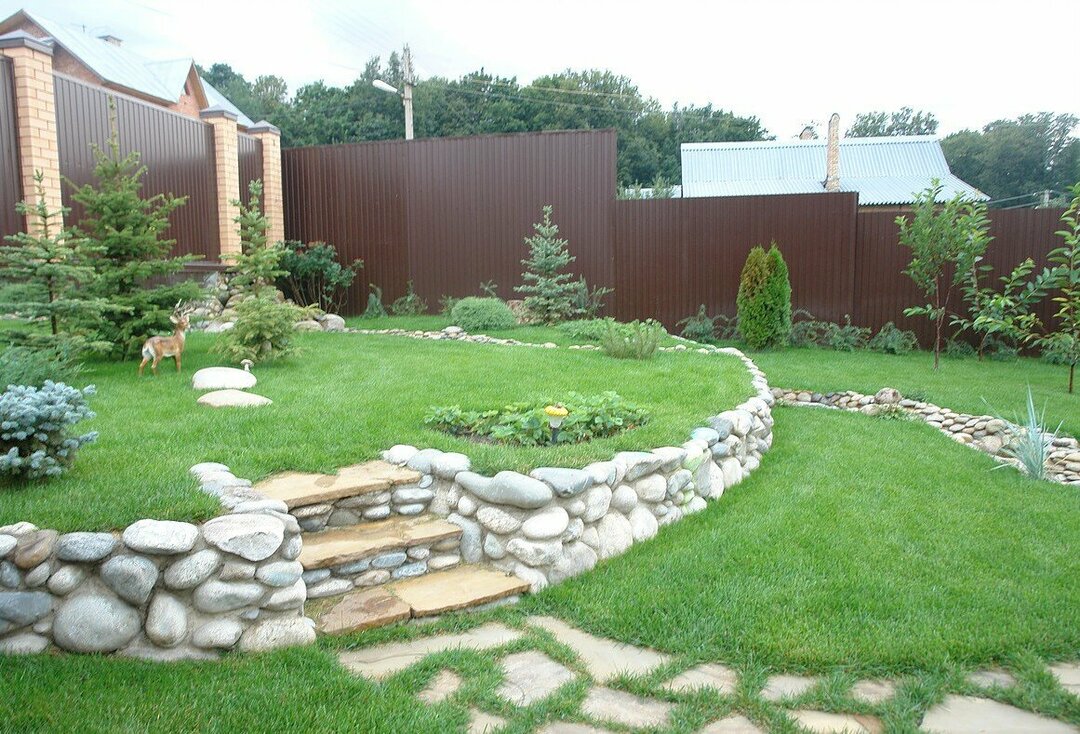
From cobblestones of different sizes, retaining walls are often laid out on areas with relief
- Pebbles. Small fragments of rocks, ranging in size from 1 to 10 cm. It acquires an unusual shape due to the action of water sources or coastal waves.

River or sea pebbles can be used in a wide variety of applications in the garden.
- Lumps. This variety is often of particular interest to landscape designers, as it has a rough natural shape. Such stones have sharp corners, chips, interesting edges. The peculiarity of the lumps is their impressive size.

Massive boulders will play an accent role in the landscape and will draw attention to the place where they are installed
- Crushed stone. This material appears as a result of rock crushing. Grainy in texture.

Tracks, rockeries and rocky flower beds are poured with rubble
- Sand and screening of stone chips. The smallest "representative" of stones. The size of individual fragments is no more than 5 mm.

Screening of stone chips is usually used for garden paths
There are also three forms of stones:
- Round. Typical for river rocks. Being exposed to water for a long time, the stone acquires smooth lines and uniform outlines.

Spherical stones look very original on the site, although they artificially give the ideal shape to such a decor
- Flat. This shape is a sign of a rock.
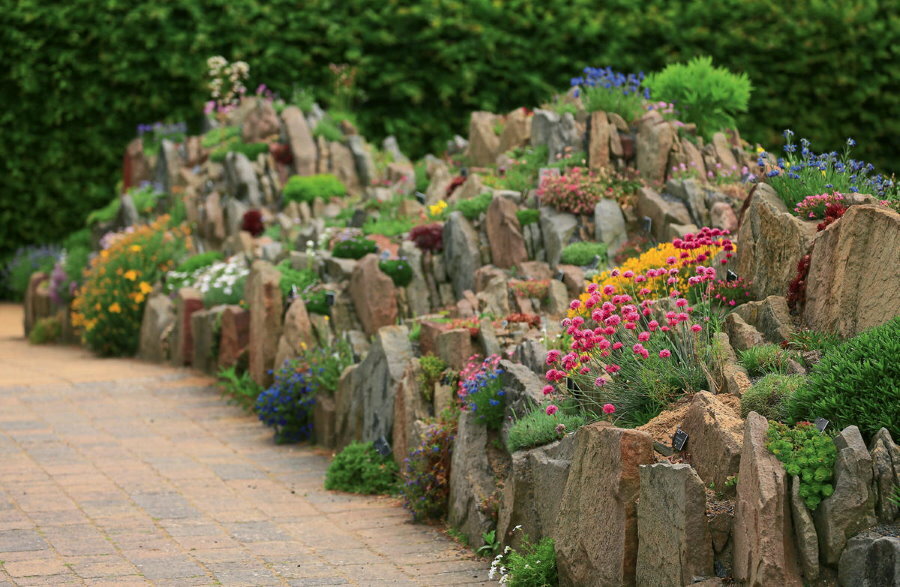
Flat stones are used not only for paving paths, but also for creating spectacular rock gardens
- Brick. This name is rather arbitrary, it is just that the stone has a semblance of a rectangular shape and well-defined angles.
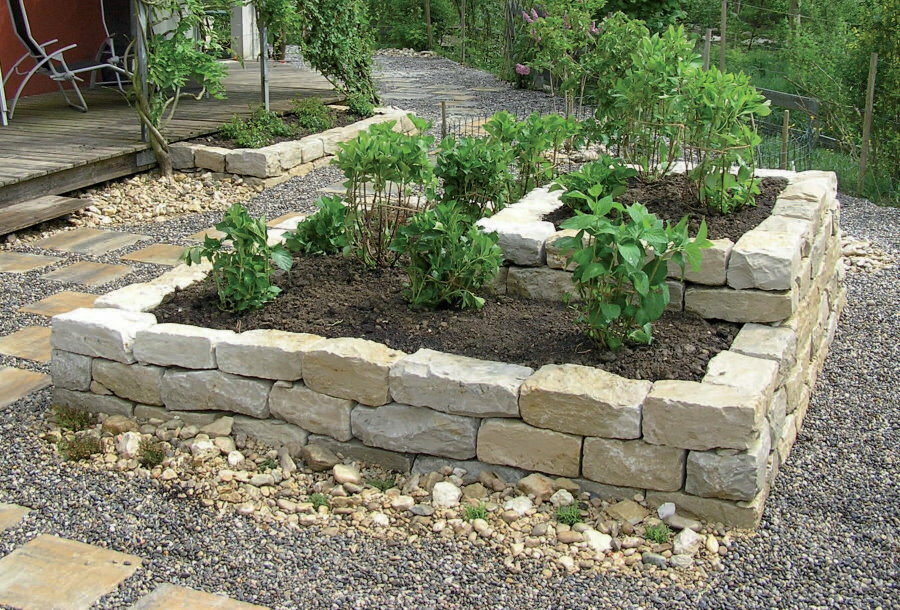
Neat sides for flower beds or beds come out of stones of the correct shape
Where to buy
If you have a clear idea of what kind of composition you will create, there is only one question left to decide: where to get the stone?
With no extra funds, you can get this material absolutely free. For example, carefully examine nearby areas for quarries or dry bodies of water. Perhaps, stones of suitable shape and size will be found on the territory of demolished buildings or construction sites.

Local rubble stone was often used in old buildings.
If there are abandoned summer cottages or estates in your neighborhood, it is better not to take stones from there yourself. After all, if you do not see the owners of nearby hacienda, this does not mean that they are not there, or that they will approve of your venture. Try to find contacts and resolve the issue in a legal manner.
Finally, if the game of pathfinders is not your strong point, you can simply buy the stone for the garden in the right amount. Usually, stone processing enterprises, or companies offering all kinds of goods for arranging the local area, are engaged in the sale of such material. Note that the cost is affordable, and it depends on the type of stone (granite, shell rock) and on its size (pebbles, boulders).
To determine how much stone is required to equip your territory, take into account a simple calculation: 2-3 tons of stone per 1 cubic meter. m. backyard territory.

In order for the stone composition to look harmonious, boulders and cobblestones must be commensurate with the scale of the structure.

The most beautiful and noticeable stones must be positioned so that they are clearly visible in the composition.
Varieties of stone jewelry
Stone decor is used in different styles of landscape design. In particular, it is impossible to imagine high-tech, antique landscape, modernist style, classicism, and, of course, Japanese minimalism (the so-called rock garden) without stone elements.

Stones can act as a spectacular backdrop for plants, or, conversely, serve as expressive accents among the abundance of vegetation.
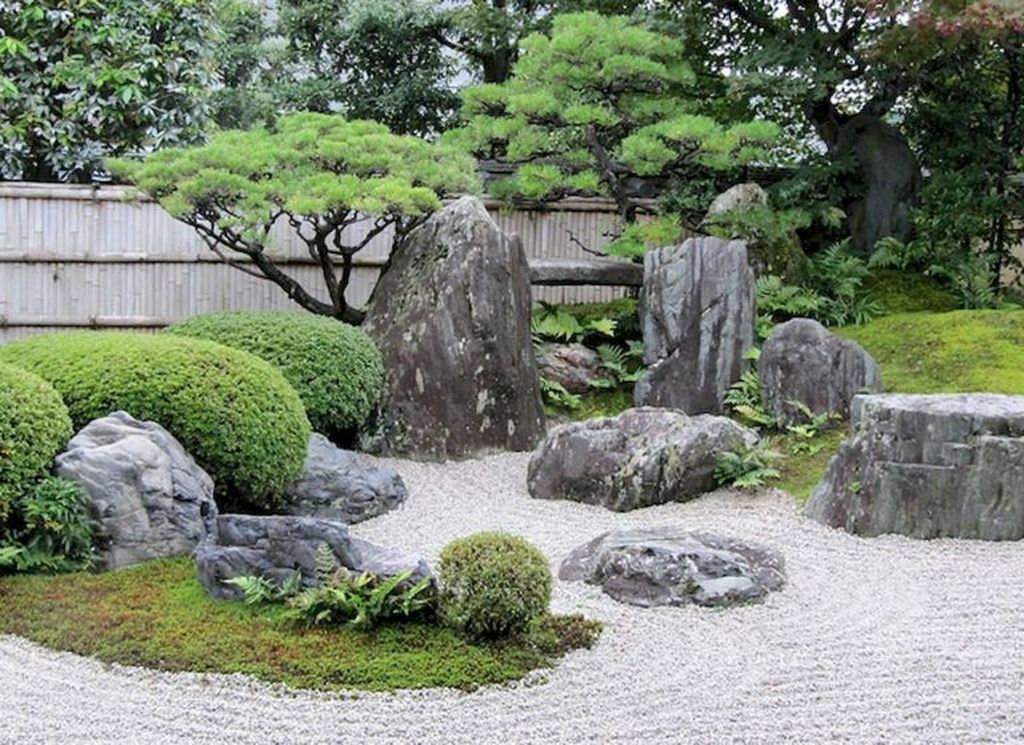
In the Japanese garden, special attention is paid to the choice of stone, its color, shape and texture, as well as the location
The Japanese style deserves special attention. Boulders are placed in groups of three stones each. The remaining area is covered with white sand or gravel. And on the surface, characteristic stripes are made, like on a water surface. This imitation is not accidental, since sand is a symbol of the world's oceans, and boulders are rocks (land). Each element in the rock garden is carefully selected. It only at first glance seems that the stones are arranged in a chaotic order, in fact, everything is subject to the system and has a deep meaning.

There are very few plants in a Japanese garden, and all of them should emphasize the symbolic meaning laid down by the creator of the garden.
There are several rules for the arrangement of elements in a Japanese rock garden:
- There should be more horizontally located stones than vertical elements.
- There should be emptiness against the background of boulders. This is considered a symbol of freedom of the spirit.
- No symmetry, parallel lines, or identical details.
- Balance in each group. For this, the triangle rule applies: there is always a main element and several subordinates.
- A stone cannot just lie on the surface. It is important to give the impression that the boulder is growing out of the ground. For this, the stones are deepened. Moreover, on a slope they deepen more than on a flat surface.
- Seven points of view. When planning your rock garden, draw a heptagonal star. And place stones on seven faces. But do this so that each element is visible from seven points of view (from seven vertices). Someone claims that with such an arrangement, fifteen peaks are visible. And the whole point is that the stones have uneven outlines and the illusion of bifurcation is created.
Now let's look at other ways to use stones to decorate the landscape.
One of the most common decorative elements is the stone spiral. It's easy to make, even a beginner can handle it. Small flat stones are stacked in a spiral. This decor is used both in front of the front of the cottage and in the recreation area. It looks very impressive.
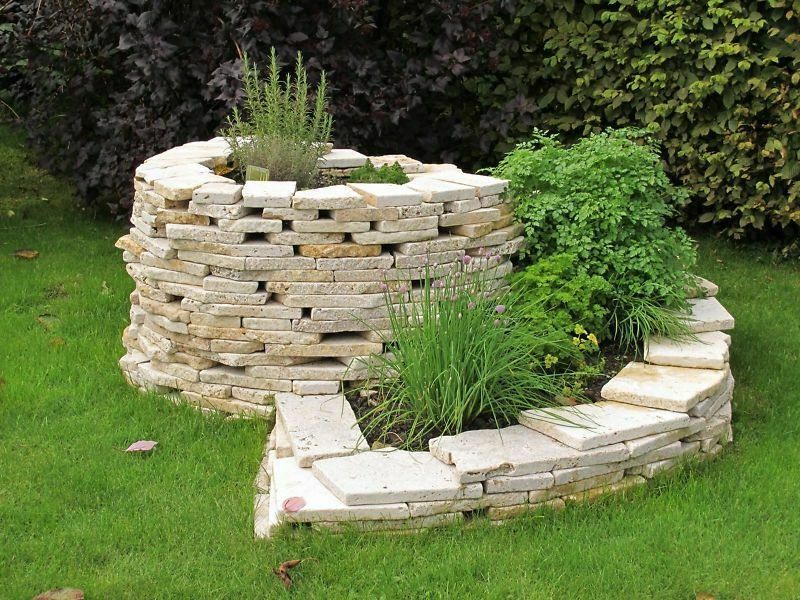
In the photo, a spiral flower bed, laid out with your own hands from a flat stone
If you have multi-colored stones at your disposal, then lay them out with an ornament. By the way, for such a decoration, they use not only materials of different colors, but also materials of different sizes. Having laid out the paths in the summer cottage in this way, you will not only make it attractive in appearance, but also solve the problem of excess moisture and ice in winter. So it's also very practical.

In the photo there is a playground in a garden made of colored stones, neatly laid with a beautiful pattern
Gabions are another way to use garden stones functionally. Mesh frames filled with stones will perfectly cope with the role of a fence, and with the creation of an unusual flower bed. Finally, the gabion itself as a small architectural form will make your site unique in its kind. By the way, one of the most practical ways to use gabions is the creation of barbecues and ovens. Thus, aesthetics and functionality are perfectly matched.

There are many options for using gabions in the country, for example, they can be used to fence off a plot

The versatility of the design allows you to use gabions in the most unexpected places

Even in the barbecue area, gabions will find a worthy use.
Today you will not surprise anyone with a stone slide, but it does not lose its popularity. By adding a few large stones to a regular flower bed, you add creativity to your site. A flower bed of stones is within the power of even a novice gardener. All you need is flat stones, some cement, and of course, fantasy. Any lawn with a similar decor will sparkle with new colors.

Different stones are suitable for decorating a flower bed, in size and shape, and the greater the difference between the stones, the more natural the composition looks
A dry stream of fine gravel and colored pebbles will take root in any size and shape. This decor, unlike a real stream, will never dry out or change its appearance.
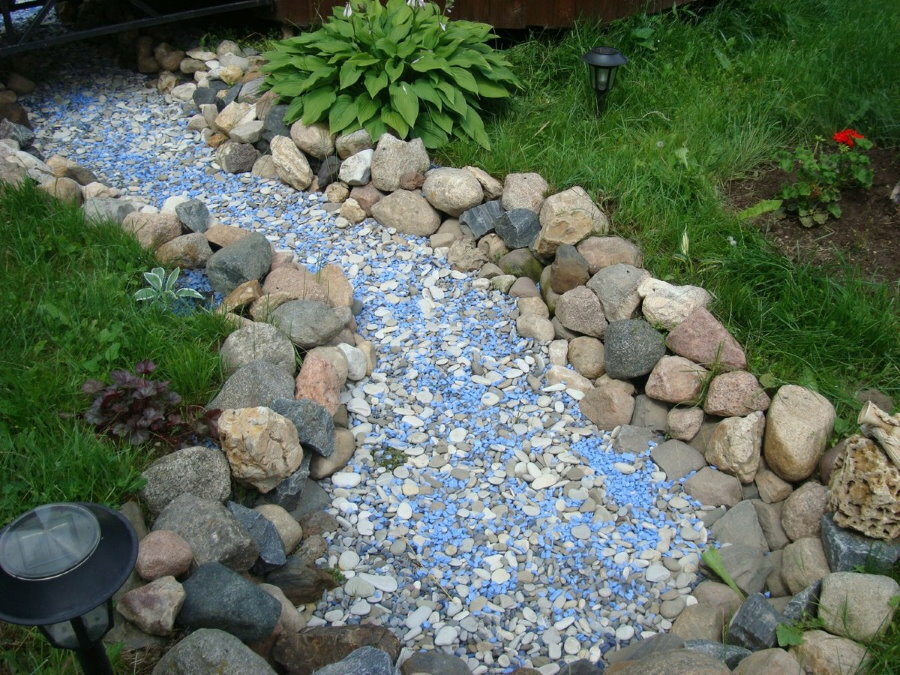
The contours of a dry stream can be marked with large stones, and the channel can be covered with colored rubble
With the help of stones, decorative ponds are often made out. The easiest, accessible to all, way to equip a small water source on the site is to take a wooden barrel and surround it with stones.

The best garden decoration is a combination of natural stone and water.
Stones look unusually beautiful in the design of fountains. And if you have a pump pump at your disposal, then you can make a real waterfall or a whole cascade of waterfalls, and effectively decorate them with stones.
The main rule of the landscape is harmony. Do everything in such a way that you get the impression that this is not the work of your hands, but the result of natural "efforts". Do not strive to use all known types of stone on your site. Such an abundance will not decorate, but, on the contrary, spoil the most spectacular landscape design.



